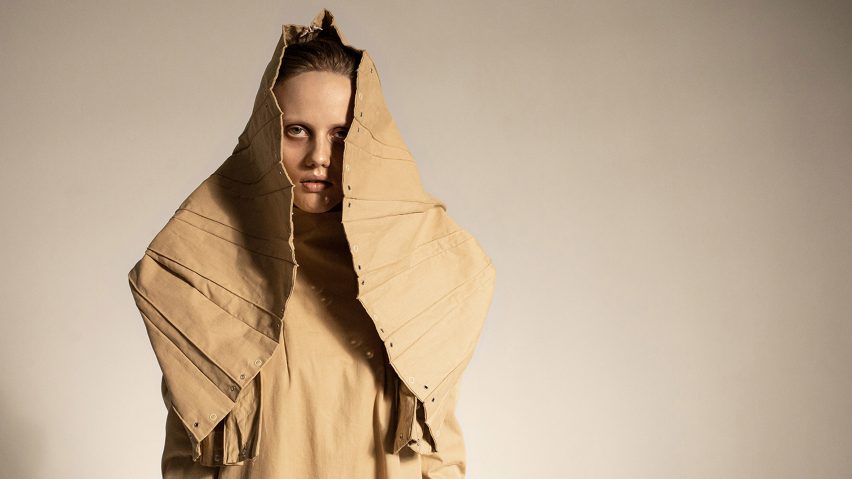The founder of Ukrainian clothing brand DZHUS has created an impromptu collection based on a single suitcase of garments salvaged when she was forced to flee as Russian forces invaded.
Dzhus told Dezeen of the "extreme challenge" of escaping the conflict.
"Keeping in mind that I might need to walk long distances with three cats (in two carriers), I could only take as much luggage as I'd still be able to bear," she explained.
The designer, who is now a refugee in Warsaw, fled from her home in the city of Vyshhorod with one suitcase containing "half the stock" from her eponymous brand's Spring Summer 2022 collection, Physique.
Like many Ukrainians, she left the country as the situation worsened following the Russian army's invasion, which began on 24 February.
"I got petrified with terror. In five minutes, I was packing an emergency bag. We called our relatives to check if they were alive," recounted Dzhus.
"Our evacuation journey was quite an extreme challenge," said continued. "After the Russian terror began, we had to wait in our [apartment] block's basement for four days until there occurred a chance to get to the central railway station, from which evacuation trains departed."
"The first few days were the most horrific," she said. "I was so shocked that I could neither sleep nor eat or even breathe properly."
Since arriving in Warsaw, the designer has begun investigating ways that the brand can continue to operate, while DZHUS is also donating a portion of the profits made from selling its evacuated garments to charities in Ukraine.
"At the moment, I'm just getting to know Warsaw's infrastructure and exploring sourcing and manufacturing opportunities for production purposes," she explained.
"To say we have relocated the DZHUS studio would be an exaggeration. For now, I feel very lucky to have evacuated myself and brought our latest drop with me."
The Physique collection is characterised by dramatic, androgynous silhouettes crafted in materials such as ribbed wool and crumpled organza.
While the collection was shown in its entirety during last September's Ukrainian Fashion Week and also in a showroom at Paris Fashion Week, only the evacuated pieces are currently for sale online.
Selected pieces that have formed this reduced collection include a four-way transforming maxi dress made from creased, ecru-coloured material and a statement shirt featuring a detachable pleated jersey hood that also doubles up as a bag.
"All the garments are transformers – some can even be turned into accessories," said the designer, who defined the garments' materials as "unusual textiles".
"Traditionally for DZHUS, the palette is very reserved, limited to black, white and beige shades, to draw all the focus to the shape of our multi-purpose designs."
The brand is currently donating "30 to 50 per cent" of the profits made from selling these pieces to Come Back Alive, a charity that supports Ukrainian servicepeople, as well as animal shelters Sight and Plyushka, and animal rights group UAnimals – organisations that the fashion label feels align with its values.
DZHUS is using the remainder of the funds from the sales to keep the brand afloat during this uncertain period and is also expecting the arrival of more garments that relatives have managed to post to Poland despite the ongoing crisis.
The designer's husband and business partner Anatolli Elgert also escaped from Vyshhorod but has had to remain in the western part of Ukraine following the couple's difficult journey.
DZHUS is known for its architecturally precise garments, such as its previous Nihilism collection of clothes that can be folded into different angular shapes and another structural collection featuring silhouettes "dedicated to the evolution of earth".
In February, various other architects and designers told Dezeen how the war in Ukraine has affected their lives and work by forcing them to flee the country.
The images are courtesy of DZHUS. The portrait is by Julia Weber.

